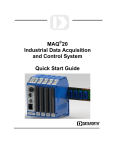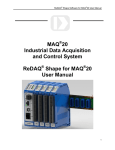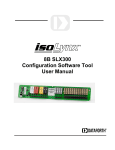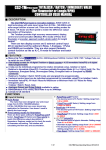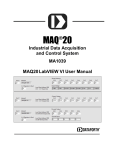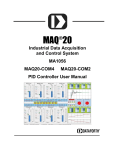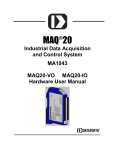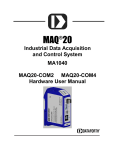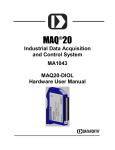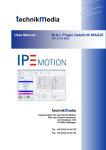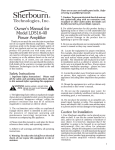Download Configuration SW Tool User Manual
Transcript
® MAQ 20 Industrial Data Acquisition and Control System Configuration Software Tool User Manual MAQ®20 Configuration Software Tool User Manual ® MAQ 20 Industrial Data Acquisition and Control System Configuration Software Tool User Manual MA1037 Rev. B – May 2012 © 2012 Dataforth Corporation. All Rights Reserved. ISO9001:2008-Registered QMS The information in this manual has been checked carefully and is believed to be accurate; however, Dataforth assumes no responsibility for possible inaccuracies or omissions. Specifications are subject to change without notice. The information, tables, diagrams, and photographs contained herein are the property of Dataforth Corporation. No part of this manual may be reproduced or distributed by any means, electronic, mechanical, or otherwise, for any purpose other than the purchaser’s personal use, without the express written consent of Dataforth Corporation. ® MAQ 20 is a registered trademark of Dataforth Corporation. ii MAQ®20 Configuration Software Tool User Manual Table of Contents 1.0 MAQ®20 Communication Setup 1.1 Quick Setup ................................................................................................................................... 1 1.2 MAQ 20 Communication Setup & Connection ........................................................................... 1 ® 2.0 MAQ®20 Configuration Software Tool Panel 2.1 Registration Tab ............................................................................................................................ 3 2.2 Module Data Tab ........................................................................................................................... 4 3.0 Configuring the MAQ®20 Communications Module 3.1 Communication Settings ............................................................................................................... 5 3.2 Real Time Clock ............................................................................................................................ 5 3.3 Logging Settings ........................................................................................................................... 5 4.0 Configuring the MAQ®20 Volt/Millivolt Input Module 4.1 Input Channel Configuration ......................................................................................................... 6 4.2 Analog Input Readings .............................................................................................................. 6 4.3 Alarm Configuration for Input Channels ........................................................................................ 7 4.4 Reset Input Readings .................................................................................................................... 7 ® 5.0 Configuring the MAQ 20 Thermocouple Input Module 5.1 TC Channel Configuration ............................................................................................................. 8 5.2 TC Input Readings ........................................................................................................................ 8 5.3 Alarm Configuration for TC Input Channels .................................................................................. 9 5.4 Reset TC Input Readings .............................................................................................................. 9 6.0 Configuring the MAQ®20 Voltage Output Module 6.1 Voltage Output and Range Values ............................................................................................. 10 6.2 Load Buffer Data Values ............................................................................................................. 10 6.3 Voltage Output Default Values .................................................................................................... 11 7.0 Configuring the MAQ®20 Discrete Voltage Output Module 7.1 Discrete I/O Configuration ........................................................................................................... 12 7.2 Discrete I/O Special Function Alarms ......................................................................................... 13 7.3 Special Function Panels ............................................................................................................. 14 7.3.1 Pulse / Frequency Counter Function ................................................................................. 14 iii MAQ®20 Configuration Software Tool User Manual 7.3.2 Pulse / Frequency Counter with De-bounce Function ....................................................... 14 7.3.3 Waveform Measurement Function ..................................................................................... 14 7.3.4 Time Between Events Function ......................................................................................... 14 7.3.5 Frequency Generator Function .......................................................................................... 15 7.3.6 PWM Generator Function .................................................................................................. 15 7.3.7 One-Shot Pulse Generator Function .................................................................................. 15 iv MAQ®20 Configuration Software Tool User Manual About Dataforth Corporation “Our passion at Dataforth Corporation is designing, manufacturing, and marketing the best possible signal conditioning, data acquisition, and data communication products. Our mission is to set new standards of product quality, performance, and customer service.” Dataforth Corporation, with more than a quarter ® century of experience, is the worldwide leader in Instrument Class Industrial Electronics – rugged, high performance signal conditioning, data acquisition, and data communication products that play a vital role in maintaining the integrity of industrial automation, data acquisition, and quality assurance systems. Our products directly connect to most industrial sensors and protect valuable measurement and control signals and equipment from the dangerous and degrading effects of noise, transient power surges, internal ground loops, and other hazards present in industrial environments. Dataforth spans the globe with more than 50 International Distributors and US Representative Companies. Our customers benefit from a team of over 130 sales people highly trained in the application of precision products for industrial markets. In addition, we have a team of application engineers in our Tucson factory ready to solve any in-depth application questions. Upon receipt of an RFQ or order, our Customer Service Department provides fast one-day delivery information turnaround. We maintain an ample inventory that allows small quantity orders to be shipped from stock. Contacting Dataforth Corporation Contact Method E-Mail: Technical Support Website: Phone: Fax: Mail: Contact Information [email protected] www.dataforth.com 520-741-1404 and toll free 800-444-7644 520-741-0762 Dataforth Corporation 3331 E. Hemisphere Loop Tucson, AZ 85706 Errata Sheets Refer to the Technical Support area of Dataforth’s website (www.dataforth.com) for any errata information on this product. v MAQ®20 Software Configuration User Guide 1.0 MAQ®20 Communication Setup 1.1 Quick Setup 1. Download the Configuration Software Tool from the Dataforth website, www.dataforth.com and follow the installation procedure. If the system will be used with a USB connection to the host PC, the USB Driver must be installed prior to connecting the system to the computer. Download the driver from www.dataforth.com and follow the installation instructions. ® 2. Start the MAQ 20 Configuration Software Tool program by double-clicking the icon MAQ20 Config SW Tool shortcut on the desktop. Alternately there is a MAQ20 Config SW Tool shortcut under the Start menu / All Programs / MAQ20 program group. ® 3. Connect the appropriate communication cable and supply the MAQ 20 with 7-32VDC power. 4. From the main menu select Communication and then click Configure. 5. Set up the appropriate communication settings and click the Connect button. The default settings are: RS-232 & RS-485 Communication - 115.2kbps, even parity, Slave ID 16 Ethernet Communication - Static IP Address 192.168.128.100. 1.2 MAQ®20 Communication Setup & Connection After the software is started, the initial panel displays with the View Panel disabled, indicating that the ® application is not yet connected to the MAQ 20 system, reference Figure 1. Figure 1: Configuration Software Tool, View Panel Disabled 1 MAQ®20 Configuration Software Tool User Manual From the Communication pull-down menu, select Configure. The Communication Setup panel will appear giving the user the ability to configure the communication port, reference Figure 2. Figure 2: Communication Setup Panel If the system is connected via RS-232 or RS-485, ensure the RS-232, RS-485 radio button is selected. Select the appropriate Communication Port number from the Port # drop-down menu. For the initial connection leave the Baud Rate, Parity and Slave ID unchanged. If the serial communication port number is not known, press the Find Comm Port button. This will execute a process that will search through the Serial Comm Ports on the host ® computer and detect which port the MAQ 20 system is connected If the system is connected via USB, the USB devices found will be populated in the Device # drop down box. Select one and click the Connect button. The Refresh USB button will execute a process to detect any new USB Communication Ports that have been added to the system and populate them in the Device # drop down list found in the USB Devices group ® box. If the MAQ 20 system was not connected prior to opening this setup panel, click on this button prior to continuing. If the system is connected via Ethernet, ensure the Ethernet radio button is selected. For initial connection leave the IP Address unchanged. The host computer Ethernet port must be configured with a fixed IP Address of 192.168.xxx.xxx, which does not match the static IP ® Address of the MAQ 20 and Subnet Mask of 255.255.0.0. ® Once the communication parameters have been set, click the Connect button. The MAQ 20 Software panel will come to center screen. If the connection and setup are correct, the bar graph on the bottom left ® corner of the panel will start moving and the main screen will show the MAQ 20 I/O modules present in the system. If these actions do not occur, the connection to the system failed. Verify the communication cable connections and communication setup parameters and try connecting again. 2 MAQ®20 Configuration Software Tool User Manual 2.0 MAQ®20 Configuration Software Tool Panel The File menu has a Print function which allows the user to send the system configuration details to a printer as well as save them to a text file located in the C:\Dataforth\MAQ20\MAQ20 Config SW Vx.x folder. The Log Configure function under the File menu allows the user to log data selected in the Module Comm panel to a text file. Features of the Module Comm tab are explained in Section 2.2 When a system is first started, I/O modules are automatically registered. The order of module registration and display in the software may not match the physical location of the modules on the backbone. To reorder the display in the software to match the physical location, select the Reorder Modules check box and use the Up and Down buttons to change the order as desired. Once finished, press the Save button to make the changes permanent. Figure 3: Configuration Software Tool, View Panel Active 2.1 Registration Panel: This tab displays each of the modules that have been registered by the MAQ20-COMx module. The registration process may take a few seconds to complete depending on whether the system is being connected for the first time and the number of I/O modules installed. To configure a specific module, first click in any cell of the row where the module data is displayed and then click the Configure Module button. 3 MAQ®20 Configuration Software Tool User Manual Figure 4: Configuration Software Tool, Module Comm Tab 2.2 Module Data Panel: This tab allows the monitoring of up to 5 different registered modules or up to 5 different addresses spaces of the same module. First select the module to be monitored using the Module # drop down box, next select the address to be monitored from the Address drop down box, and last, select the number of addresses to be monitored using the Read Qty numeric up/down box. An address map listing data locations can be found in the MA10xx MAQ20 Hardware User Manual for the specific I/O Module being used. This Module Data Panel also allows the user to write to specific addresses by double-clicking on the cell that corresponds to the address to be written to. This action opens a new panel where the user can write the desired value and the number of addresses to write. The starting address of the write panel will correspond to the address of the cell that was double-clicked on. 2.2.1 2.2.2 2.2.3 2.2.4 4 Update Options: Poll the I/O modules in Continuous or Single Read mode using the appropriate radio button. Update Timer Settings: In Continuous mode, the poll interval can be increased or decreased using this numeric up/down box. Update Display Settings: Changes the display of information read from or written to the I/O modules. Display Data: Opens a second panel that logs all of the active address spaces. MAQ®20 Configuration Software Tool User Manual 3.0 Configuring the MAQ®20 Communications Module Figure 5: MAQ20-COMx Communications Module Configuration Panel 3.1 Communication Settings: This panel allows the Ethernet and Serial communications parameters of the MAQ20-COMx module to be changed. The factory default values for Ethernet communications are; IP Address 192.168.128.100, Subnet Mask 255.255.0.0. For RS-232 or RS-485 communications factory default values are; Baud Rate 115200bps, Parity Even and Slave ID 16. If the parameters are changed, press the Write button to send the parameters to the MAQ20-COMx module and press the Save button to save the parameters to the system non-volatile memory. 3.2 Real Time Clock: To modify the system real time clock settings, select the Edit RTC check box and change the parameters. Press the Write RTC button to save the settings to the system. 3.3 Logging Settings: Start address, quantity of addresses to log, log file name, number of samples to log and logging intervals are specified in this section. The system micro-SD card size and free memory are also displayed. The Calculate Log Settings section allows the user to calculate Samples, Interval or Duration given two of the three variables. For example if you know how many samples you would like to take and at what rate you are taking them this tool will calculate the Duration of the sample period. NOTE: To retrieve data from the SD card, remove it from the system, place it in the provided USB adapter and read the card using the host computer or other appropriate system. 5 MAQ®20 Configuration Software Tool User Manual 4.0 Configuring the MAQ®20 Volt/Millivolt Input Modules Figure 6: MAQ20-VDN Voltage Input Module Configuration Panel To configure the module click on any cell in a row of the Main Registration Panel and then click the Configure Module button this will open the MAQ20 volt input configuration panel. The three types of Voltage Input Modules are 8-channel differential voltage input, 8-channel differential Millivolt input and 16channel single ended voltage input. Selectable on a channel-by-channel basis, the input ranges for the Voltage input models are ±60V, ±40V, ±20V, ±10V and ±5V and the input ranges for the Millivolt model are ±2V, ±1V, ±0.25V, ±0.1V and ±0.05V. 4.1 Input Channel Configuration: Input Range settings can be set on a channel-by-channel basis along with the Avg Weight used for the average value calculation. The average calculation uses 2^(Avg Weight) samples, i.e. the average calculation for the configuration shown above uses the most recent 2^(3) = 8 samples. If changes are made to the Range or the Avg Weight, the appropriate Set button must be pressed to write the settings to the module nonvolatile memory. A Scan List is provided to give the ability to scan between 1 and n sequential channels, where n = 8 for 8-channel modules and n = 16 for 16-channel modules. A Scan List value of n specifies that channels 0 through n-1 will be sampled. The default scan list setting is 8 for differential modules and 16 for single ended modules. Pressing the Set button sends the data to the input module and the scan list will remain active until the next power cycle. Press the Save button to store the settings to the module nonvolatile memory. 4.2 Analog Input Readings: Data read from each of the active channels is displayed in this section. Data can be displayed in Counts or Engineering Units (Volts). If the Loop Read check box is selected data will update every 0.5 second and if it is unselected, data is manually updated by pressing the Read button. The Read Type drop down box gives the user the ability to select what type of readings will be displayed (Current, Average, Maximum or Minimum). The Alarm Status colors are used when channels are configured with alarm 6 MAQ®20 Configuration Software Tool User Manual limits. When an alarm limit for a given channel is exceeded, the background color of the cell displaying data for that channel will change indicate which limit has been exceeded. 4.3 Alarm Configuration for Input Channels: This section is used to configure alarm settings for each channel. Alarm choices are High, Low, HighHigh and Low-Low. High / Low and High-High / Low-Low ranges have separate Dead Bands which can be specified. Alarm limits must have the same units as the Analog Input Readings (Counts or Engineering Units). Enter the alarm limits and press the Set Alarm Settings button to write the values to the module. Press the Save button to store the settings to the module nonvolatile memory. 4.4 Reset Input Readings: These buttons clear the registers used to store the Maximum, Minimum and Average values of data read from each channel. 7 MAQ®20 Configuration Software Tool User Manual 5.0 Configuring the MAQ®20 Thermocouple Input Module Figure 7: MAQ20-JTC Thermocouple Input Module Configuration Panel To configure the module click on any cell in a row of the Main Registration Panel and then click the Configure Module button this will open the MAQ20 Thermocouple Input Module. Four modules are offered to interface to five different thermocouple types; one for Type J, one for Type K, one for Type T and one for Types R and S. 5.1 TC Channel Configuration: Input Range settings can be set on a channel-by-channel basis along with the Avg Weight used for the average value calculation. The average calculation uses 2^(Avg Weight) samples, i.e. the average calculation for the configuration shown above uses the most recent 2^(3) = 8 samples. If changes are made to the Range or the Avg Weight, the appropriate Set button must be pressed to write the settings to the module nonvolatile memory. A Scan List is provided to give the ability to scan between 1 and n sequential channels, where n = 8 for 8-channel modules and n = 16 for 16-channel modules. A Scan List value of n specifies that channels 0 through n-1 will be sampled. The default scan list setting is 8. Pressing the Set button sends the data to the input module and the scan list will remain active until the next power cycle. Press the Save button to store the settings to the module nonvolatile memory. 5.2 TC Input Readings: Data read from each of the active channels is displayed in this section. Data can be displayed in Counts or Engineering Units (deg C). If the Loop Read check box is selected data will update every 0.5 second and if it is unselected, data is manually updated by pressing the Read button. The Read Type drop down box gives the user the ability to select what type of readings will be displayed (Current, Average, Maximum or Minimum). The Alarm Status colors are used when channels are configured with alarm limits. When an alarm limit for a given channel is exceeded, the background color of the cell displaying data for that channel will change indicate which limit has been exceeded. The Conv Tool button opens a utility that converts temperature to Millivolts or Millivolts to temperature. 8 MAQ®20 Configuration Software Tool User Manual 5.3 Alarm Configuration for TC Input Channels: This section is used to configure alarm settings for each channel. Alarm choices are High, Low, HighHigh and Low-Low. High / Low and High-High / Low-Low ranges have separate Dead Bands which can be specified. Alarm limits must have the same units as the Analog Input Readings (Counts or Engineering Units). Enter the alarm limits and press the Set Alarm Settings button to write the values to the module. Press the Save button to store the settings to the module nonvolatile memory. 5.4 Reset TC Input Readings: These buttons clear the registers used to store the Maximum, Minimum and Average values of data read from each channel. 9 MAQ®20 Configuration Software Tool User Manual 6.0 Configuring the MAQ®20 Voltage Output Module Figure 8: MAQ20-VO Voltage Output Module Configuration Panel To configure the module click on any cell in a row of the Main Registration Panel and then click the Configure Module button this will open the MAQ20 Voltage Output Module configuration panel. 6.1 Voltage Output and Range Values: Output Range settings can be set for the 8 isolated outputs on a channel-by-channel basis. Voltage Out values can be changed by typing a value in the numeric up/down panel and pressing enter or using up and down arrows. 6.2 Load Buffer Data Values: Preset data and data sequences such as waveforms can be stored on a channel-by-channel basis and then written to the module outputs on a single-shot or continuous basis. Select a channel using the Chan # numeric up/down box and then select the number of data points to write using the Write Qty numeric up/down box. Enter values in Engineering Units (Volts) and press the Write button to send the data to the module. The Pointer numeric up/down box will be automatically incremented to indicate what address will be written next. Press the Save button to store the data in the module nonvolatile memory. To read data stored in module memory, first enter the Pointer value and write it to the module using the Write Ptr button, then press the Read button. Data entry can be simplified using the Load Values from File function. A sample file with data for common waveforms like sine and cosine is provided in the directory where the software is installed. Press the Select File button, browse to the appropriate location (typically C:\Dataforth\MAQ20\MAQ20 Config SW Tool ), select the file, then press the Load File button to write the data to the module. The Save button is used to store the data in the module nonvolatile memory. 10 MAQ®20 Configuration Software Tool User Manual Preset data can be output to between 1 and n sequential channels up to a maximum of 8 channels. Use the Channels numeric up/down box in the Buffer Interval n Chans group box to enter the number of channels to write to, and press the Set button to send the selection to the module. Data will remain in module memory until the next power cycle. Press the Save button to store the settings in the module nonvolatile memory. A Channels value of n specifies that preset data will be written to channels 0 through n-1. The default Channels setting is 8. The interval in milliseconds between written samples is modified using the next numeric up/down box below the Channels box. The current setting is displayed next to the box. Minimum interval is 10ms and the default value is 10ms. Press the Set button to send the selection to the module and the Save button to store the settings in the module nonvolatile memory. 6.3 Voltage Output Default Values: Default values for the module outputs upon power cycle, brown out, reset, or system fault can be specified on a channel-by-channel basis. To change the default value, select a channel using the Chan # numeric up/down box and enter the new value in the numeric up/down box. Press the Set button to send the selection to the module and the Save button to store the settings in the module nonvolatile memory. 11 MAQ®20 Configuration Software Tool User Manual 7.0 Configure the MAQ®20 Discrete Input/Output Module Figure 9: MAQ20-DIO Discrete Input/Output Module Configuration Panel To configure the module click on any cell in a row of the Main Registration Panel and then click the Configure Module button this will open the MAQ20 Discrete Input/Output Module configuration panel. 7.1 Discrete I/O Configuration: The I/O channel display on the panel represents the fixed configuration of the module. Starting from the top, the first 5 channels are Discrete Output and the last 5 are Discrete Input. The current state of the channels is displayed in the Status column. The state of the Output channels can be changed by selecting the channel number from the Chan pull down menu and pressing the Toggle button. The Default Out state of the Output modules can be changed by clicking on the cell corresponding to the Output channel and entering a value of “0” or “1”. Data will remain in module memory until the next power cycle. Press the Save button to store the settings in the module nonvolatile memory. 12 MAQ®20 Configuration Software Tool User Manual 7.2 Discrete I/O Special Function Alarms: The Discrete I/O Module can perform seven special functions. Some of these special functions use set pairs of channels. This area of the panel sets the alarm conditions for Discrete Input channels 5-6 and 78. 7.2.1 Inputs: Use this drop-down box to select the channels for which alarms will be set: Ch 56 or Ch 7-8. 7.2.2 Function: Select the function from the drop-down box. There are only four Special Functions that can have alarms: Pulse/Frequency Counter (Pulse/Freq Counter), Pulse/Frequency Counter with De-bounce (Pulse/Freq Ctr Debnc), Waveform Measurement, and Time Between Events. Only one of these can be configured at a time for each channel pair. 7.2.3 Alarm: Each special function has different parameters it monitors for alarms, which are one or more of the following: Pulse Count, Frequency, RPM, Events Measured, Positive Pulse Width and Time Between Events. 7.2.4 Alarm Type: Tracking or Latching. Tracking: This type of alarm will trigger once the conditions are met and will reset when the alarm conditions are no longer present. Latching: This type of alarm will trigger once the conditions are met and will not reset until the user resets it manually, even if the alarm condition is no longer present. 7.2.5 Alarm Limit: Select the limit that will be monitored. Options are: Low, High, High & Low, Low & Low-Low, High & High-High, and All Limits. 7.2.6 Alarm Out: Any alarm can have two outputs. An alarm condition can either be reported by only a flag or by a flag and an action sent to a discrete output channel. If a discrete output channel is selected, the output can be set High or Low on alarm. Alarms are mapped to specific output channels. For input channels 5-6 the High-Low alarm is mapped to Output Channel 0 and High-High Low-Low alarm is mapped to Output Channel 1. For input channels 7-8 the High-Low alarm is mapped to Output Channel 2 and High-High Low-Low alarm is mapped to Output Channel 3. In the Alarm Out dropdown box there are two words separated by a comma; the first word is for High-Low alarms and the second is for High-High Low-Low alarms. Atv Low will mean that when the alarm is triggered the alarm output will go Low, Atv High is the opposite and Reg will not use an output it will just report to a register. Alarm Output Status Atv Low Atv High Reg 7.2.7 Untriggered Triggered 1 0 0 1 Unchanged Unchanged Limits: Alarm limits are set based on the required function and action. DB stands for deadband. Once alarm configuration is complete, press the Set button to send the data to the module and the Save button to store the data in the module nonvolatile memory. To clear an alarm setting, press the Reset button followed by the Save button. 13 MAQ®20 Configuration Software Tool User Manual 7.3 Special Function Panels: Special functions operate using preset channels associated with one of two Timers: Channels 0, 1, 5 and 6 are associated with Timer 0 and Channels 2, 3, 7 and 8 are associated with Timer 1. Each of the two timers can run any one of the seven special functions at any given time. The panel displays the special functions selected for each of the two timers. Below is a description of the Special Functions that can be run on the Discrete Input / Output Module. 7.3.1 Pulse / Frequency Counter Function Uses input channel 5 for Timer 0 and input channel 7 for Timer 1. Select rising or falling edge Pulse Count = Number of pulses since last enable or last clearing of the counter RPM Specify ticks per revolution for use with RPM Frequency 7.3.2 Pulse / Frequency Counter with De-bounce Function Uses input channel 5 for Timer 0 and input channel 7 for Timer 1. The de-bounced signal uses output channel 0 for Timer 0 and output channel 2 for Timer 1. The De-bounce means that the signal must remain the specified length of time in the state before the output will be toggled. Select rising or falling edge Specify length of time that input must remain high; time is in increments of 100µs Specify length of time that input must remain low; time is in increments of 100µs Can output de-bounced signal to third channel of the bank Pulse Count = Number of pulses since last enable or last clearing of the counter Frequency 7.3.3 Waveform Measurement Function Uses input channel 5 for Timer 0 and input channel 7 for Timer 1. Select rising or falling edge Specify number of events to measure before stopping Events measured counter Specify timebase, from 1 second to 1µs Provides Current as well as Average, Maximum and Minimum high time readings as a function of the timebase Provides Current as well as Average, Maximum and Minimum low time readings as a function of the timebase Frequency Duty cycle Period 7.3.4 Time Between Events Function Uses input channels 5 and 6 for Timer 0 and input channel 7 and 8 for Timer 1. Select rising or falling edge Specify number of events to measure before stopping Specify average weight Specify timebase, from 1 second to 1µs Provides Current as well as Average, Maximum and Minimum time between events as a function of the timebase 14 MAQ®20 Configuration Software Tool User Manual Frequency 7.3.5 Frequency Generator Function Uses output channel 0 for Timer 0 and output channel 2 for Timer 1. Can generate a frequency between 1 and 10kHz Waveform will have a duty cycle of 50% 7.3.6 PWM Generator Function Uses output channel 0 and 1 for Timer 0 and output channel 2 and 3 for Timer 1. This function allows the user to generate a waveform up to 10kHz with a user defined duty cycle. The frequency of both outputs is the same but the duty cycle can be varied by changing the low time for each of the channels. Specify timebase, from 1µ second to 1second Specify PWM period as a function of the timebase Specify first channel low time as a function of the timebase (Chan 0 for Timer 0 or Chan 2 for Timer 1) Specify second channel low time as a function of the timebase (Chan 1 for Timer 0 or Chan 3 for Timer 1) Enable/disable second channel as output 7.3.7 One-Shot Pulse Generator Function Uses output channel 0 and 1 for Timer 0 and output channel 2 and 3 for Timer 1. This function allows the user to generate a single or multiple pulse waveform with a specified pulse width. The pulse can be repeated either by a software command trigger or by a rising edge on the first channel. The user can specify a Pre-Delay which will execute once the trigger has been received and/or a Post-Delay which will be used to ignore any triggers until the delay has expired. Specify timebase, from 1µ second to 1second Specify trigger for pulse generation: Software command, hardware rising edge or hardware falling edge Specify number of pulses to generate before stopping Specify output pulse polarity as positive or negative Count of number of pulses generated Specify length of pulse as a function of the timebase Specify length of pulse Pre-Delay as a function of the timebase Specify length of pulse Post-Delay as a function of the timebase 15 MAQ®20 Configuration Software Tool User Manual DATAFORTH WARRANTY Applying to Products Sold by Dataforth Corporation a. General. Dataforth Corporation (“Dataforth”) warrants that its products furnished under this Agreement will, at the time of delivery, be free from defects in material and workmanship and will conform to Dataforth's applicable specifications or, if appropriate, to buyer's specifications accepted in writing by Dataforth. DATAFORTH'S OBLIGATION OR LIABILITY TO BUYER FOR PRODUCTS WHICH DO NOT CONFORM TO THE ABOVE STATED WARRANTY SHALL BE LIMITED TO DATAFORTH, AT DATAFORTH'S SOLE DISCRETION, EITHER REPAIRING, REPLACING, OR REFUNDING THE PURCHASE PRICE OF THE DEFECTIVE PRODUCT(S) PROVIDED THAT WRITTEN NOTICE OF SAID DEFECT IS RECEIVED BY DATAFORTH WITHIN THE TIME PERIODS SET FORTH BELOW: i. for all software products including licensed programs, thirty (30) days from date of initial delivery; government, or governmental agency of any country resulting directly or indirectly (i) from any acts not authorized by Dataforth in writing or any statements regarding the products inconsistent with Dataforth's product documentation or standard warranty, or (ii) from any breach or threatened breach by buyer, or by any of its employees or agents, of any term, condition or provision of this Warranty or (iii) from any warranty, representation, covenant or obligation given by buyer to any third party and not expressly provided for in this Warranty or (iv) for any non-compliance (in any form) of the products with any necessary or mandatory applicable laws, regulations, procedures, government or industry policies or requirements related to the use, sale or importation of the products. Such indemnification shall include the payment of all reasonable attorneys' fees and other costs incurred by Dataforth in defending such claim. c. ii. for all hardware products including complete systems, one (1) year from date of initial delivery; iii. for all special products, sixty (60) days from date of initial delivery; and further, all products warranted hereunder for which Dataforth has received timely notice of nonconformance must be returned FOB to Dataforth's plant in Tucson, Arizona USA within thirty (30) days after the expiration of the warranty periods set forth above. The foregoing warranties shall not apply to any products which Dataforth determines have, by buyer or otherwise, been subjected to operating and/or environmental conditions in excess of the maximum value established therefor in the applicable specifications, or any products that have been the subject of mishandling, misuse, misapplication, neglect, improper testing, repair, alteration or damage. THE PROVISIONS OF THE FOREGOING WARRANTIES EXTEND TO BUYER ONLY AND NOT TO BUYER'S CUSTOMERS OR USERS OF BUYER'S PRODUCTS. THE DATAFORTH STANDARD WARRANTY IS IN LIEU OF ALL WARRANTIES OF MERCHANTABILITY AND FITNESS FOR A PARTICULAR PURPOSE OR USE AND ALL OTHER WARRANTIES WHETHER EXPRESS, IMPLIED OR STATUTORY, EXCEPT AS TO TITLE. THE DATAFORTH STANDARD WARRANTY MAY BE CHANGED BY DATAFORTH WITHOUT NOTICE. b. Buyer Indemnity. Buyer agrees to indemnify and hold Dataforth harmless from and against any and all claims, damages and liabilities whatsoever asserted by any person, entity, industry organization, 16 Limitation on Damages. (1) IN NO EVENT SHALL DATAFORTH, ITS SUPPLIERS, LICENSORS, SERVICE PROVIDERS, EMPLOYEES, AGENTS, OFFICERS, AND DIRECTORS BE LIABLE FOR INDIRECT, SPECIAL, INCIDENTAL, COVER, ECONOMIC, PUNITIVE, ACTUAL, EXEMPLARY, CONSEQUENTIAL OR OTHER DAMAGES OF ANY NATURE INCLUDING, WITHOUT LIMITATION, LOST PROFITS OR REVENUES, COSTS OF REPLACEMENT PRODUCTS, LOSS OR DAMAGE TO DATA ARISING OUT OF THE USE OR INABILITY TO USE ANY DATAFORTH PRODUCT. (2) IN NO EVENT SHALL DATAFORTH BE LIABLE FOR DIRECT, SPECIAL, INDIRECT, INCIDENTAL OR CONSEQUENTIAL DAMAGES OF ANY NATURE RESULTING FROM BUYER’S NONCOMPLIANCE (IN ANY FORM) WITH ALL NECESSARY OR MANDATORY APPLICABLE LAWS, REGULATIONS, PROCEDURES, GOVERNMENT POLICIES OR REQUIREMENTS RELATED TO THE USE, SALE OR IMPORTATION OF PRODUCTS. (3) IN NO EVENT WILL THE COLLECTIVE LIABILITY OF DATAFORTH AND ITS SUPPLIERS, LICENSORS, SERVICE PROVIDERS, EMPLOYEES, AGENTS, OFFICERS, AND DIRECTORS TO ANY PARTY (REGARDLESS OF THE FORM OF ACTION, WHETHER BASED UPON WARRANTY, CONTRACT, TORT, OR OTHERWISE) EXCEED THE GREATER OF EITHER US$1000.00 (ONE THOUSAND DOLLARS U.S.A. CURRENCY) OR THE AMOUNT PAID TO DATAFORTH FOR THE APPLICABLE PRODUCT OR SERVICE OUT OF WHICH LIABILITY AROSE. MAQ®20 Configuration Software Tool User Manual (4) DATAFORTH’S LIABILITY ARISING OUT OF THE PRODUCTION, SALE OR SUPPLY OF PRODUCTS OR THEIR USE OR DISPOSITION, WHETHER BASED UPON WARRANTY, CONTRACT, TORT OR OTHERWISE, SHALL NOT EXCEED THE GREATER OF EITHER US$1000.00 (ONE THOUSAND DOLLARS U.S.A. CURRENCY) OR THE ACTUAL PURCHASE PRICE PAID BY BUYER FOR DATAFORTH'S PRODUCTS. DATAFORTH'S LIABILITY FOR ANY CLAIM OF ANY KIND SHALL IN NO CASE EXCEED THE OBLIGATION OR LIABILITY SPECIFIED IN THIS WARRANTY. d. Technical Assistance. Dataforth 's Warranty as hereinabove set forth shall not be enlarged, diminished or affected by, and no obligation or liability shall arise or grow out of, Dataforth's rendering of technical advice, facilities or service in connection with buyer's order of the products furnished hereunder. e. Warranty Procedures. Buyer shall notify Dataforth of any products which it believes to be defective during the applicable warranty period and which are covered by the Warranty set forth above. Buyer shall not return any products for any reason without the prior authorization of Dataforth and issuance of a Return Material Authorization ("RMA") number. After issuance of a RMA number, such products shall be promptly returned by buyer (and in no event later than thirty (30) days after the Warranty expiration date), transportation and insurance prepaid, to Dataforth's designated facility for examination and testing. Dataforth shall either repair or replace any such products found to be so defective and promptly return such products to buyer, transportation and insurance prepaid. Should Dataforth's examination and testing not disclose any defect covered by the foregoing Warranty, Dataforth shall so advise buyer and dispose of or return the products in accordance with buyer's instructions and at buyer's sole expense, and buyer shall reimburse Dataforth for testing expenses incurred at Dataforth's then current repair rates. f. Repair Warranty. Dataforth warrants its repair work and/or replacement parts for a period of ninety (90) days from receipt by buyer of the repaired or replaced products or for the remainder of the warranty period for the initial delivery of such order as set forth in paragraph a above, whichever is greater. g. Critical Applications. Certain applications using Dataforth's products may involve potential risks of death, personal injury, or severe property or environmental damage ("Critical Applications"). DATAFORTH'S PRODUCTS ARE NOT DESIGNED, INTENDED, AUTHORIZED, OR WARRANTED TO BE SUITABLE FOR USE IN LIFE-SUPPORT DEVICES OR SYSTEMS, SAFETY EQUIPMENT, NUCLEAR FACILITY APPLICATIONS OR OTHER CRITICAL APPLICATIONS WHERE MALFUNCTION OF THE PRODUCT CAN BE EXPECTED TO RESULT IN PERSONAL INJURY, DEATH OR SEVERE PROPERTY DAMAGE. BUYER USES OR SELLS SUCH PRODUCTS FOR USE IN SUCH CRITICAL APPLICATIONS AT BUYER'S OWN RISK AND AGREES TO DEFEND, INDEMNIFY AND HOLD HARMLESS DATAFORTH FROM ANY AND ALL DAMAGES, CLAIMS, PROCEEDINGS, SUITS OR EXPENSE RESULTING FROM SUCH USE. h. Static Sensitive. Dataforth ships all product in anti-static packages. Dataforth's Warranty as hereinabove set forth shall not cover warranty repair, replacement, or refund on product or devices damaged by static due to buyer's failure to properly ground. 17 MAQ®20 Configuration Software Tool User Manual _____________________________________________________________________________________________ Application Support Dataforth provides timely, high-quality product support. Call 1-800-444-7644 TOLL-FREE. Returns/Repair Policy All warranty and repair requests should be directed to the Dataforth Customer Service Department at (520) 741-1404. If a product return is required, request a Return Material Authorization (RMA) number. You should be ready to provide the following information: 1. Complete product model number. 2. Product serial number. 3. Name, address, and telephone number of person returning product. 4. Special repair instructions. 5. Purchase order number for out-of-warranty repairs. The product should be carefully packaged, making sure the RMA number appears on the outside of the package, and ship prepaid to: Dataforth Corporation 3331 E. Hemisphere Loop Tucson, AZ 85706 USA The information provided herein is believed to be reliable; however, DATAFORTH assumes no responsibility for inaccuracies or omissions. DATAFORTH assumes no responsibility for the use of this information, and all use of such information shall be entirely at the user's own risk. Application information is intended as suggestions for possible use of the products and not as explicit performance in a specific application. Prices and specifications are subject to change without notice. No patent rights or licenses to any of the circuits described herein are implied or granted to any third party. DATAFORTH does not authorize or warrant any DATAFORTH product for use in life support devices and/or systems. ® MAQ 20 Industrial Data Acquisition and Control System Configuration Software Tool User Manual MA1037 Rev. B – May 2012 © 2012 Dataforth Corporation. All Rights Reserved. ISO9001:2008-Registered 18

























